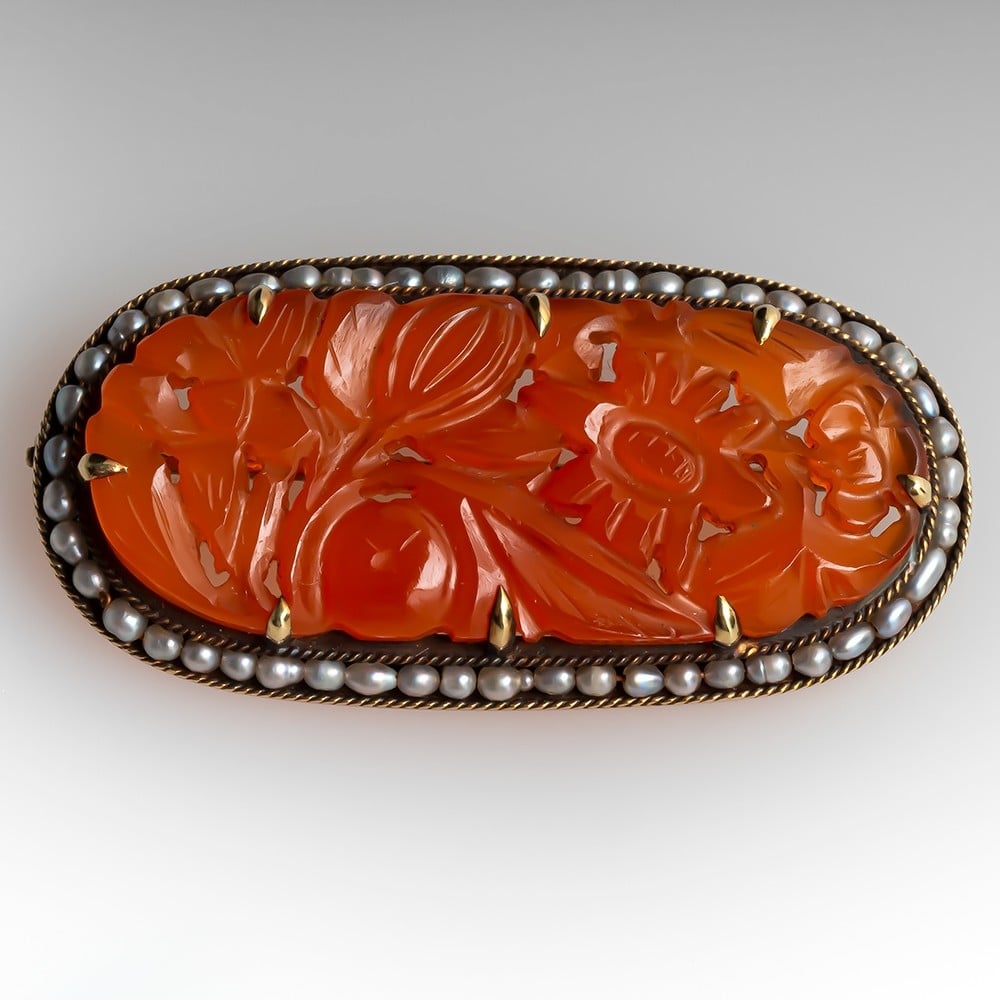Posted in: Birthstones
 Carnelian jewelry represents an ancient tradition of stone carving. Beautiful in its reddish-orange hues, it often appears in antique jewelry. Photo ©2019 EraGem Jewelry.
Carnelian belongs to the mineral family quartz. Its history dates back 4,500 years, at which time Ancient Sumerians and Ancient Egyptians fashioned it into body ornaments. The Ancient Greeks and Romans also favored the semi-precious gemstone for intaglios which they used in signet rings. Given its long history, the beautiful reddish-brown stone often appears in antique jewelry.
Carnelian jewelry represents an ancient tradition of stone carving. Beautiful in its reddish-orange hues, it often appears in antique jewelry. Photo ©2019 EraGem Jewelry.
Carnelian belongs to the mineral family quartz. Its history dates back 4,500 years, at which time Ancient Sumerians and Ancient Egyptians fashioned it into body ornaments. The Ancient Greeks and Romans also favored the semi-precious gemstone for intaglios which they used in signet rings. Given its long history, the beautiful reddish-brown stone often appears in antique jewelry.
Where Carnelian is Found
Geologists assert that carnelian first surfaced in the Bengal region of India. Traditionally, Indian miners place the brownish stone in the sun to transform it into a rich red color. Later, miners discovered deposits in South Africa, Madagascar, Brazil, Uruguay, and the United States. These remain to date the most important sources of the reddish brown stone. Additional major deposits occur in Australia, the Czech Republic, England, France, Germany, and Sri Lanka. Smaller deposits exist in Iceland, Japan, Peru, Poland, Romania, Russia, and Slovakia. In the United States, it occurs in Washington, Tennessee, Connecticut, New Jersey, Oregon, and Florida. The primary contemporary sources for carnelian remain India and Brazil.Early Use of Carnelian
The known history of man dates back farther than 10,000 BC. Between 10,000 BC and 4,500 BC, a lot changed for humans. Up until that time, humans lived a nomadic lifestyle, foraging and hunting, always on the move looking for food. However, one people group experimented with crude farming techniques, allowing them to enjoy a more sedentary lifestyle. From that point on, farming slowly expanded into the booming industry we know today. Midway through this long stone age (around 5,500 BC), Bulgarian tribes began fashioning red chalcedony into beads. Since carnelian belongs to the red chalcedony family, it is likely that this is the first use of the stone in history. Evidence surfaced in the Varna Necropolis, an ancient burial site, demonstrating that the Bulgarians not only used the rich red stone, but also faceted it. These early faceted crystals contained 16 facets on each side. In spite of this compelling evidence, the Sumerian culture, thriving in 4,500 BC, often receives credit as the first peoples to use carnelian. Around the same time, Egyptians fashioned the stone into talismans and amulets for protection. Clearly, the rich red stone captivated many cultures across time. No wonder the ancients identified it as the zodiac birthstone for the sign Virgo. (source)Carnelian Characteristics
As a member of the quartz chalcedony family, carnelian primarily consists of silicon dioxide. However, how these elements form varies widely within this large family of gemstones. Mineralogists categorize them into to distinctive classification branches, macrocrystalline and cryptocrystalline. Carnelian belongs to the latter, meaning its crystal structure can only be seen under magnification. Other members of this branch include onyx, jasper, agate, and sard. This beautiful gemstone stands apart from its siblings with its color. Ranging from red-orange to brownish-orange, it owes its color to iron oxide. True specimens demonstrate a uniformity in color. If the stone exhibits banding, mineralogists classify it as a hybrid carnelian/agate. (source) Buyer beware, the presence of banding in a stone may indicate treatments of agate to pass the stone off as carnelian. True carnelian, when held up to a light source, demonstrates a cloudy coloring throughout. While it may contain light and dark zones, they will appear cloudy rather than banded. Furthermore, although some specimens display opacity, experts classify the stone as translucent. Therefore, even if a specimen appears nearly opaque in the center, it will be see-through at least along the edges. As I mentioned before, antique jewelry often features carnelian. At EraGem, we love antique pieces featuring this stone. Click here to view a selection of jewels featuring this rich red stone. ~Angela Magnotti Andrews5 years ago
97 view(s) 